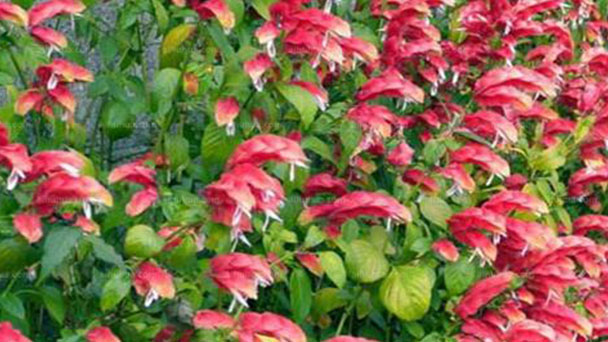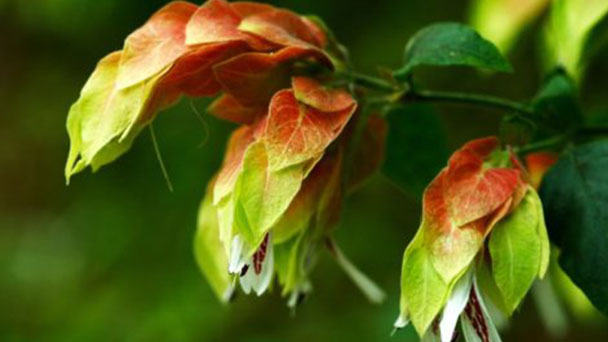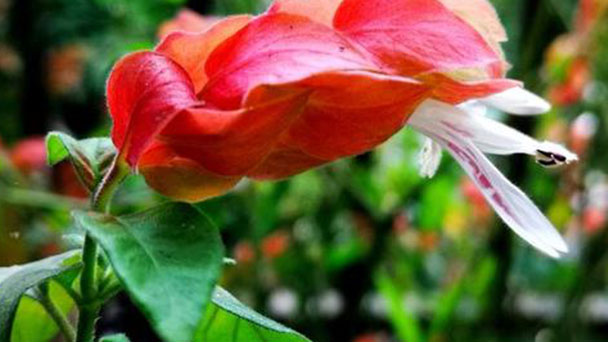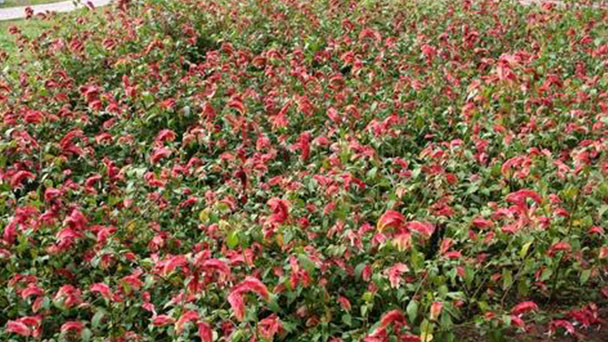Justicia brandegeana profile
Written by Maggie
Nov 12 2020

Justicia brandegeana is a perennial herb or evergreen subshrub of Acanthaceae and Euphorbiaceae. The plant height is 1-2 meters, the stem is thin and branched, and the whole plant is hairy. Leaves ovate or elliptic, entire. Spikes are terminal and drooping, 6-9 cm long, with brown, red, yellow-green or yellow persistent bracts, white flowers, lip-shaped, shrimp-like flowers, upper lip entire or 2-lobed, lower lip 3 shallow Split, with 3 rows of purple spots at the base. Justicia brandegeana is a kind of Capsule.
Justicia brandegeana is native to Mexico and is cultivated all over the world. Likes warm and moist, likes light and is more resistant to shade, not cold. Reproduction is based on cuttings. The bracts overlap in clusters and tilt down, and the inflorescence is about 10 cm long, resembling lobster and foxtail, which is very interesting. It blooms all year round and is suitable for potted plants. It can be placed indoors on an elevated shelf for viewing and can also be used as a flowerbed arrangement.
Justicia brandegeana picture

Morphological characteristics of Justicia brandegeana
Herbs multibranched, 20-50 cm tall; stems terete, short bristles. The leaves are ovate, 2.5-6 cm long, short and acuminate at the top, and narrow at the base to form a slender stalk, with short bristles on both sides.
Justicia brandegeana spikes are compact, slightly curved, 6-9 cm long; bracts brick red, 1.2-1.8 cm long, pubescent; calyx white, about 1/4 of the crown tube; corolla white, in There are red spots on the throat, 3.2 cm long, extending beyond the bracts, and the crown is deeply split to the middle, and is pubescent. The capsule has not been seen.
Justicia brandegeana's growth habit and geographical distribution
Growth habit
Justicia brandegeana likes moist, more drought-tolerant, loose, fertile and well-drained neutral and slightly acidic soil. Full-day or half-day, sex like warm, humid environment, cultivate in the greenhouse. The minimum temperature needs to be: 5~10℃, suitable for growth temperature: 18~28℃ like sunshine and more tolerant, avoid exposure to the sun, like moisturizing. Blooming all year round. The fruiting period is throughout the year. Justicia brandegeana habit: sex likes warm, humid environment, cultivated in greenhouse. The minimum temperature needs to be 5~10℃. It is also more resistant to the sun, avoiding sun exposure, and prefers moisturizing. Blooming all year round.

Geographical distribution
Justicia brandegeana is very common in gardens and flowerbeds in southern China. Both potted plants and open field plants grow well, such as those in Haikou People’s Park in Hainan. The central region must live through the winter in the greenhouse. Native to Mexico, Yisheng, Florida, USA.
Propagation of Justicia brandegeana
Cuttings
Justicia brandegeana is usually reproduced by cuttings. It can be operated all year round except in the hot summer and humid period, and it is easy to survive, but spring and autumn are suitable. Generally, after the blooming period of Justicia brandegeana in June, combined with shaping and pruning, select the strong branches of the year as cuttings, each segment has 3 nodes, and one leaf at the base is removed and inserted into a loose substrate such as plain sand and vermiculite. After inserting the film, keep it warm and moisturizing, sparse the shade, and keep it at 20°C to 25°C. It will take about two weeks to take roots, plant them in time, and bloom the next year.
sowing
Before sowing, the Justicia brandegeana seeds must be selected first. The selection of the seeds is directly related to the success of the sowing. It is best to use seeds harvested that year. The longer the seed is stored, the lower its germination rate. Choose Justicia brandegeana seeds with full grains, no defects or deformities, and no pests. Soak the seeds in warm water (the temperature is similar to that of face wash) for 12-24 hours, until the seeds absorb water and swell.
For very common seeds that are easy to germinate, this work can be omitted. For small seeds that are difficult to pick up by hand or other tools, you can moisten one end of the toothpick with water, stick the Justicia brandegeana seeds one by one on the surface of the substrate, and cover the substrate with a thickness of 1 cm. Put the flowerpot in the water, the depth of the water is 1/2 to 2/3 of the height of the flowerpot, let the water slowly soak up.
For the larger seeds that can be clamped by hand or other tools, put the Justicia brandegeana seeds directly into the substrate and plant them at a distance of 3×5 cm. Cover the substrate after sowing, and the thickness of the cover is 2 to 3 times that of the seeds. After sowing, you can use a sprayer or a fine-hole shower to wet the seeding substrate. Then, when the pot soil is slightly dry, you should spray water again, and still pay attention to not too much watering to avoid washing up the seeds;
Management after sowing: After sowing in late autumn, early spring or winter, when the cold wave is low, you can wrap the flower pot with plastic film to keep warm and moisturize; after justicia brandegeana seedlings are unearthed, the film should be uncovered in time and Before 9:30 in the morning, or after 3:30 in the afternoon, let the seedlings receive the sun, otherwise the seedlings will grow very weak;
After most of the Justicia brandegeana seeds have emerged, they need to be thinned appropriately: pull out the diseased and unhealthy seedlings so that the remaining seedlings have a certain space between each other; when most of the seedlings have grown 3 pieces Or you can transplant after 3 or more leaves.
Layering
Select strong branches and peel off the bark from about 15 to 30 cm below the top tip. The width of the wound after peeling is about 1 cm, and the depth is limited to the skin just peeled off. Cut a piece of film that is 10-20 cm long and 5-8 cm wide. Put some wet garden soil on it and wrap the girdling part like a wound. Tie the upper and lower ends of the film tightly and bulge in the middle. Take root in about four to six weeks. After Justicia brandegeana takes root, the roots of the branches are cut off together to form a new plant.

Use value of Justicia brandegeana
Justicia brandegeana blooms all year round, the bracts are persistent, overlapped in clusters, like lobsters, very interesting, suitable for potted plants, placed indoors on elevated racks to watch the seasons, and can also be used as flower beds or bonsai. Potted plants decorate window sills, study rooms, balconies, and can also be planted on the side of the road and walls of the courtyard for viewing.
In the garden, Justicia brandegeana is often planted on the roadside and flowerbeds for viewing.
Latest Updated
- Benefits of Bugleweed - 7 Science-backed Health Benefits
- Bugleweed Dangers & Side Effects - Is It Poisonous?
- How to Plant Evergreen Trees - What You Should Know
- When to Plant Evergreens - Grow Guide for Evergreen Trees
- 12 Wonderful Evergreen Shrubs for Your Garden
- 12 Popular Evergreen Plants with Pictures for Beginners
- When And How To Prune A Lilac Bush Like a Pro
- How to Grow & Care for Lilac Vine (Hardenbergia Violacea)
- Japanese Lilac Tree (Syringa Reticulata) Care & Propagation Guide
- Shumard Oak Pros and Cons - What to Know
Popular Articles
- Winter maintenance of Antirrhinum Majus
- How to Grow Terminalia Mantaly Tree
- How to Grow and Care for Crossostephium Chinense
- How to grow Antirrhinum Majus in spring
- Peristeria Elata (Dove Orchid) Profile: Info & Care Guide
- Underwatered Snake Plant (Sansevieria Trifasciata) - Signs And How To Fix
- How to Care for Brazilian Jasmine Plant (Mandevilla Sanderi)
- How to Grow & Care for Graptopetalum Purple Delight in Summer
- Rosa Chinensis (China Rose): Plant Growing & Care Tips
- How to Care for Baby Sun Rose (Aptenia Cordifolia)